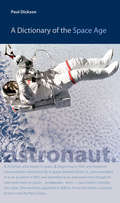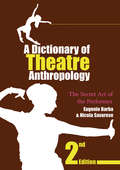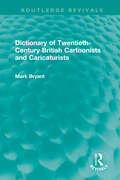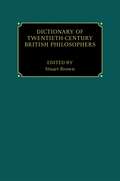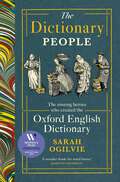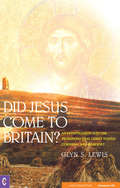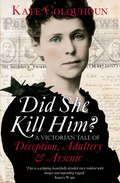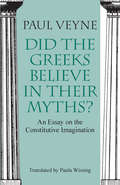- Table View
- List View
A Dictionary of the American Avant-Gardes
by Richard KostelanetzFor this American edition of his legendary arts dictionary of information and opinion, the distinguished critic and arts historian Richard Kostelanetz has selected from the fuller third edition his entries on North Americans, including Canadians, Mexicans, and resident immigrants. Typically, he provides intelligence unavailable anywhere else, no less in print than online, about a wealth of subjects and individuals. Focused upon what is truly innovative and excellent, Kostelanetz also ranges widely with insight and surprise, including appreciations of artistic athletes such as Muhammad Ali and the Harlem Globetrotters, and such collective creations as Las Vegas and his native New York City. Continuing the traditions of cheeky high-style Dictionarysts, honoring Ambrose Bierce and Nicolas Slonimsky (both with individual entries), Kostelanetz offers a "reference book" to be treasured not only in bits and chunks, but continuously as one of the ten books someone would take if they planned to be stranded on a desert isle.
A Dictionary of the American Avant-Gardes
by Richard KostelanetzFor this American edition of his legendary arts dictionary of information and opinion, the distinguished critic and arts historian Richard Kostelanetz has selected from the fuller third edition his entries on North Americans, including Canadians, Mexicans, and resident immigrants. Typically, he provides intelligence unavailable anywhere else, no less in print than online, about a wealth of subjects and individuals. Focused upon what is truly innovative and excellent, Kostelanetz also ranges widely with insight and surprise, including appreciations of artistic athletes such as Muhammad Ali and the Harlem Globetrotters, and such collective creations as Las Vegas and his native New York City. Continuing the traditions of cheeky high-style Dictionarysts, honoring Ambrose Bierce and Nicolas Slonimsky (both with individual entries), Kostelanetz offers a "reference book" to be treasured not only in bits and chunks, but continuously as one of the ten books someone would take if they planned to be stranded on a desert isle.
A Dictionary of the History of Medicine
by Anton SebastianThis is a unique, extensively illustrated dictionary of terms, people, events, and dates spanning the entire history of medicine. It is a monumental work of scholarship totaling some 700 double-column pages with a large number of rare and exceptional illustrations from many original sources painstakingly compiled over years of far-searching inquiry involving more than 5,000 books and hundreds of journals. It is a major resource of hard-to-find information about notable medical figures, instruments, conditions, procedures, and dates and a storehouse of captivating anecdotes and background material. The book contains a wealth of material for concise historical introductions to a broad range of subjects and is the sine qua non authority on both well and little known facts of medical history. With this single volume-an unprecedented tour de force representing more than 7,000 hours of exhaustive research-clinicians and researchers from all fields of medicine can quickly and easily find authoritative, detailed definitions and descriptions, with dates, of medical terms and of the people and events contributing to the development of medicine from earliest times to the present day. The entries range widely from such as abacterial pyuria to zygote, including Latin and Greek origins of terms, compact biographies with dates, eponymic information of all kinds, and rarely seen drawings and photographs of antique medical instruments and little-known conditions.
A Dictionary of the History of Medicine
by Anton SebastianThis is a unique, extensively illustrated dictionary of terms, people, events, and dates spanning the entire history of medicine. It is a monumental work of scholarship totaling some 700 double-column pages with a large number of rare and exceptional illustrations from many original sources painstakingly compiled over years of far-searching inquiry involving more than 5,000 books and hundreds of journals. It is a major resource of hard-to-find information about notable medical figures, instruments, conditions, procedures, and dates and a storehouse of captivating anecdotes and background material. The book contains a wealth of material for concise historical introductions to a broad range of subjects and is the sine qua non authority on both well and little known facts of medical history. With this single volume-an unprecedented tour de force representing more than 7,000 hours of exhaustive research-clinicians and researchers from all fields of medicine can quickly and easily find authoritative, detailed definitions and descriptions, with dates, of medical terms and of the people and events contributing to the development of medicine from earliest times to the present day. The entries range widely from such as abacterial pyuria to zygote, including Latin and Greek origins of terms, compact biographies with dates, eponymic information of all kinds, and rarely seen drawings and photographs of antique medical instruments and little-known conditions.
Dictionary of the History of Science (PDF)
by William F. Bynum E. Janet Browne Roy PorterFor readers interested in the development of major scientific concepts and the role of science in the western world, here is the first conceptually organized historical dictionary of scientific thought. The purpose of the dictionary is to illuminate this history by providing a concise, single volume reference book of short historical accounts of the important themes, ideas, and discoveries of science. Its conceptual approach differentiates the dictionary from previous reference works such as books of scientific biography and makes it a convenient manual both for the general reader and for scientists interested in the origin of concepts in their own and other scientific fields.Originally published in 1982.The Princeton Legacy Library uses the latest print-on-demand technology to again make available previously out-of-print books from the distinguished backlist of Princeton University Press. These editions preserve the original texts of these important books while presenting them in durable paperback and hardcover editions. The goal of the Princeton Legacy Library is to vastly increase access to the rich scholarly heritage found in the thousands of books published by Princeton University Press since its founding in 1905.
Dictionary of the Holocaust: Biography, Geography, and Terminology
by Eric J. Epstein Philip RosenThis concise, easy-to-use resource on the Holocaust is rich in factual and statistical information, and provides a comprehensive compilation of the people and terms that are essential for an understanding of the Holocaust. In 2,000 entries, it profiles major personalities, covers concentration and death camps, cities and countries, and significant events. Also included are important terms translated from German, French, Polish, Yiddish, and twelve other languages. Biographical entries give a brief history, the person's significance, and their historical context. Geographical entries pinpoint exact locations using other cities or countries as landmarks, and give the number of Jewish inhabitants before Nazi occupation, and the percentage of Jews killed. Historical background is provided for such events as Kristallnacht and the Warsaw Ghetto Uprising, and entries on concentration and death camps give details on the nationalities interned, the camp's specific location, and its history.This reference is impressive in its scope and includes major perpetrators, bystanders, collaborators, victims, rescuers such as Righteous Gentiles, Jewish ghetto fighters, and partisans. It also explores the role of women and the complicity of physicians and industrialists during the Holocaust more fully than any other reference. This dictionary provides the information needed by students whose understanding of the Holocaust is limited by the absence of a single accessible research text.
Dictionary of the Political Thought of the People's Republic of China
by Henry Yuhuai HeFar more than a simple glossary, this unique resource provides a detailed lexicography of political and social life in China today, and deepens our understanding of the last twenty years of enormous change in the People's Republic. Each of the 1,600 entries (1) is rendered in Chinese characters; (2) is alphabetized according to pinyin, the Chinese phonetic alphabet; (3) is translated into English; and (4) is explained in terms of the situation in which it first appeared and how its meaning shifted over time. In addition to the main body of definitions and annotations, there are three appendices, abbreviations, a name index, and a bibliography.
Dictionary of the Political Thought of the People's Republic of China
by Henry Yuhuai HeFar more than a simple glossary, this unique resource provides a detailed lexicography of political and social life in China today, and deepens our understanding of the last twenty years of enormous change in the People's Republic. Each of the 1,600 entries (1) is rendered in Chinese characters; (2) is alphabetized according to pinyin, the Chinese phonetic alphabet; (3) is translated into English; and (4) is explained in terms of the situation in which it first appeared and how its meaning shifted over time. In addition to the main body of definitions and annotations, there are three appendices, abbreviations, a name index, and a bibliography.
A Dictionary of the Space Age (New Series in NASA History (PDF))
by Paul DicksonThe launch of Sputnik 1 in 1957 ushered in an exciting era of scientific and technological advancement. As television news anchors, radio hosts, and journalists reported the happenings of the American and the Soviet space programs to millions of captivated citizens, words that belonged to the worlds of science, aviation, and science fiction suddenly became part of the colloquial language. What’s more, NASA used a litany of acronyms in much of its official correspondence in an effort to transmit as much information in as little time as possible. To translate this peculiar vocabulary, Paul Dickson has compiled the curious lingo and mystifying acronyms of NASA in an accessible dictionary of the names, words, and phrases of the Space Age.Aviators, fighter pilots, and test pilots coined the phrases "spam in a can" (how astronauts felt prelaunch as they sat in a tiny capsule atop a rocket booster); "tickety-boo" (things are fine), and "the Eagle has landed" (Neil Armstrong’s famous quote when Apollo 11 landed on the Moon).This dictionary captures a broader foundation for language of the Space Age based on the historic principles employed by the Oxford English Dictionary and Webster’s New Third International Dictionary. Word histories for major terms are detailed in a conversational tone, and technical terms are deciphered for the interested student and lay reader. This is a must-own reference for space history buffs.
A Dictionary of the Space Age (New Series in NASA History (PDF))
by Paul DicksonThe launch of Sputnik 1 in 1957 ushered in an exciting era of scientific and technological advancement. As television news anchors, radio hosts, and journalists reported the happenings of the American and the Soviet space programs to millions of captivated citizens, words that belonged to the worlds of science, aviation, and science fiction suddenly became part of the colloquial language. What’s more, NASA used a litany of acronyms in much of its official correspondence in an effort to transmit as much information in as little time as possible. To translate this peculiar vocabulary, Paul Dickson has compiled the curious lingo and mystifying acronyms of NASA in an accessible dictionary of the names, words, and phrases of the Space Age.Aviators, fighter pilots, and test pilots coined the phrases "spam in a can" (how astronauts felt prelaunch as they sat in a tiny capsule atop a rocket booster); "tickety-boo" (things are fine), and "the Eagle has landed" (Neil Armstrong’s famous quote when Apollo 11 landed on the Moon).This dictionary captures a broader foundation for language of the Space Age based on the historic principles employed by the Oxford English Dictionary and Webster’s New Third International Dictionary. Word histories for major terms are detailed in a conversational tone, and technical terms are deciphered for the interested student and lay reader. This is a must-own reference for space history buffs.
A Dictionary of Theatre Anthropology: The Secret Art of the Performer
by Eugenio Barba Nicola SavareseFirst Published in 2005. A Dictionary of Theatre Anthropology subtly juxtaposes visual demonstrations of the performer’s craft, from a wealth of Eastern and Western sources. More than just a dictionary, this is a handbook for theatre practitioners and a guide for students and scholars of transcultural performance. It is the result of many years of research conducted by Eugenio Barba and the International School of Theatre Anthropology (ISTA) based in Denmark, and is now a classic foundational text. Whereas most Western research is concerned with naturalism and psychological realism in acting, the Dictionary focuses on the actor’s arduous and eclectic craft. The Dictionary aims to expand our knowledge of the possibilities of the scenic body, and of the spectator’s response to the dynamics of performance. The Dictionary has practical sections on balance, opposition and montage among other techniques, and discusses issues including The Text and the Stage, The Dilated Body and Energetic Language. This revised edition includes: three new chapters on Eurasian Theatre, Exercises and Organicity; 50 new photographs showing the performer’s craft in black and white and colour; and, for the first time, a useful bibliography and index.
A Dictionary of Theatre Anthropology: The Secret Art of the Performer
by Eugenio Barba Nicola SavareseFirst Published in 2005. A Dictionary of Theatre Anthropology subtly juxtaposes visual demonstrations of the performer’s craft, from a wealth of Eastern and Western sources. More than just a dictionary, this is a handbook for theatre practitioners and a guide for students and scholars of transcultural performance. It is the result of many years of research conducted by Eugenio Barba and the International School of Theatre Anthropology (ISTA) based in Denmark, and is now a classic foundational text. Whereas most Western research is concerned with naturalism and psychological realism in acting, the Dictionary focuses on the actor’s arduous and eclectic craft. The Dictionary aims to expand our knowledge of the possibilities of the scenic body, and of the spectator’s response to the dynamics of performance. The Dictionary has practical sections on balance, opposition and montage among other techniques, and discusses issues including The Text and the Stage, The Dilated Body and Energetic Language. This revised edition includes: three new chapters on Eurasian Theatre, Exercises and Organicity; 50 new photographs showing the performer’s craft in black and white and colour; and, for the first time, a useful bibliography and index.
Dictionary of Twentieth-Century British Cartoonists and Caricaturists (Routledge Revivals)
by Mark BryantBritish cartoonists and caricaturists are renowned worldwide. Originally published in 2000, this indispensable handbook offers a unique ‘who’s who’ of all the major artists working in Britain in the twentieth century and contains nearly 500 entries. Extensively illustrated, the book provides information on the work of artists such as Steve Bell, Gerald Scarfe, Posy Simmonds, Ronald Searle, Trog, mac and Larry as well as such past masters as David Low, Vicky, H. M. Bateman, Illingworth, Heath Robinson and more. The dictionary concentrates primarily on political cartoonists, caricaturists and joke or ‘gag’ cartoonists, actively working for the main Fleet Street national dailies and weeklies from 1900 to 1995. Each entry is cross-referenced and provides a concise biographical outline with an account of the artist’s style, influences and preferred medium. Where relevant the entry includes suggestions for further reading and notes solo exhibitions, books illustrated and works held in public collections. The Dictionary of Twentieth-Century British Cartoonists and Caricaturists offers an insight into the lives of satirical artists working during a century that provoked cartoonists and caricaturists to a pitch of comic and artistic invention that has rarely been matched.
Dictionary of Twentieth-Century British Cartoonists and Caricaturists (Routledge Revivals)
by Mark BryantBritish cartoonists and caricaturists are renowned worldwide. Originally published in 2000, this indispensable handbook offers a unique ‘who’s who’ of all the major artists working in Britain in the twentieth century and contains nearly 500 entries. Extensively illustrated, the book provides information on the work of artists such as Steve Bell, Gerald Scarfe, Posy Simmonds, Ronald Searle, Trog, mac and Larry as well as such past masters as David Low, Vicky, H. M. Bateman, Illingworth, Heath Robinson and more. The dictionary concentrates primarily on political cartoonists, caricaturists and joke or ‘gag’ cartoonists, actively working for the main Fleet Street national dailies and weeklies from 1900 to 1995. Each entry is cross-referenced and provides a concise biographical outline with an account of the artist’s style, influences and preferred medium. Where relevant the entry includes suggestions for further reading and notes solo exhibitions, books illustrated and works held in public collections. The Dictionary of Twentieth-Century British Cartoonists and Caricaturists offers an insight into the lives of satirical artists working during a century that provoked cartoonists and caricaturists to a pitch of comic and artistic invention that has rarely been matched.
Dictionary of Twentieth-Century British Philosophers: 2 Volumes
by Stuart BrownThis is a two-volume work with entries on individuals who made some contribution to philosophy in theperiod 1900 to 1960 or soon after. The entries deal with the whole philosophical work of an individual or, in thecase of philosophers still living, their whole work to date. Typically the individuals included have been born by1935 and by now have made their main contributions. Contributions to the subject typically take the form ofbooks or journal articles, but influential teachers and people otherwise important in the world of philosophymay also be included. The dictionary includes amateurs as well as professional philosophers and, whereappropriate, thinkers whose main discipline was outside philosophy.There are special problems about the term "British" in the twentieth century, partly because of humanmigration, partly because of decolonialization and the changing denotation of the term. The intention has beento include not only those who were British subjects at least for a significant part of their lives (even if theymostly lived outside what is now the U.K.) but also people who spent a significant part of their lives in Britainitself, irrespective of their nationality or country of origin. In the first category are included, for instance, anumber of people who were born and educated in Britain but who subsequently taught in universities abroad.In the second category are included those who were born elsewhere but who came to Britain and contributedto its philosophical culture.
A Dictionary of World History (Oxford Quick Reference)
by Anne Kerr Edmund WrightThis wide-ranging dictionary contains a wealth of information on all aspects of history, from prehistory right up to the present day. Over 4,000 clear, concise entries include biographies of key figures in world history (living and dead), separate entries for every country in the world (summarising key historical events), and in-depth entries on religious and political movements, international organizations, and major conflicts and events and their after-effects. For this new edition, existing entries have been revised and updated to reflect the very latest global events including changes in leadership, wars, political situations, and the statistical information given for each country (population counts, currency, languages, religions). New entries have been included for key figures who have recently come to prominence and world events. The book also contains twenty-five detailed maps linked to key historical events and topics. These include the African slave trade, the Black Death, and the Normandy campaign. Also included are over 200 country maps. The dictionary is enhanced by entry-level web links which are accessed via a dedicated companion website. Encyclopedic in scope, this ambitious A to Z provides an excellent overview of world history both for students and anyone with an interest in the subject.
The Dictionary People: LONGLISTED FOR THE WOMEN’S PRIZE FOR NON-FICTION 2024
by Sarah Ogilvie**LONGLISTED FOR THE WOMEN’S PRIZE FOR NON-FICTION 2024**'Enthralling and exuberant ... Here is a wonder-book for word-lovers' Jeanette Winterson‘A lively, entertaining, and illuminating read. I loved it’ Susie DentWhat do three murderers, Karl Marx's daughter and a vegetarian vicar have in common?They all helped create the Oxford English Dictionary.The Oxford English Dictionary has long been associated with elite institutions and Victorian men. But the Dictionary didn't just belong to the experts; it relied on contributions from members of the public. By 1928, its 414,825 entries had been crowdsourced from a surprising and diverse group of people, from astronomers to murderers, naturists, pornographers, suffragists and queer couples.Lexicographer Sarah Ogilvie dives deep into previously untapped archives to tell a people's history of the OED. Here, she reveals, for the first time, the full story of the making of one of the most famous books in the world - and celebrates the extraordinary efforts of the Dictionary People.** A Financial Times, TLS and Daunt Books Book of the Year 2023 **'Utterly fascinating, entertaining, astonishing and as clever as a box of monkeys ... I completely love it' Joanna Lumley'Full marks to Sarah Ogilvie... guaranteed to grab those of us obsessed with books, language and mystery' Financial Times'[An] astonishing book' Sunday Times'Touching ... The oddities [of language] enliven the book' Observer *Book of the Day*'[An] affectionate and accomplished book' TLS'Engaging' Spectator'Marvellous, witty and wholly original' Alan Rusbridger'Glorious and surprising' Richard Ovenden, Bodley's Librarian and author of Burning the Books‘A fascinating and delightful exploration of the Victorian world … Wonderful’ Nicola Shulman, TLS Podcast
The Dictionary Wars: The American Fight over the English Language
by Peter MartinA compelling history of the national conflicts that resulted from efforts to produce the first definitive American dictionary of English In The Dictionary Wars, Peter Martin recounts the patriotic fervor in the early American republic to produce a definitive national dictionary that would rival Samuel Johnson’s 1755 Dictionary of the English Language. But what began as a cultural war of independence from Britain devolved into a battle among lexicographers, authors, scholars, and publishers, all vying for dictionary supremacy and shattering forever the dream of a unified American language.The overwhelming questions in the dictionary wars involved which and whose English was truly American and whether a dictionary of English should attempt to be American at all, independent from Britain. Martin tells the human story of the intense rivalry between America’s first lexicographers, Noah Webster and Joseph Emerson Worcester, who fought over who could best represent the soul and identity of American culture. Webster believed an American dictionary, like the American language, ought to be informed by the nation’s republican principles, but Worcester thought that such language reforms were reckless and went too far. Their conflict continued beyond Webster’s death, when the ambitious Merriam brothers acquired publishing rights to Webster’s American Dictionary and launched their own language wars. From the beginning of the nineteenth century to the end of the Civil War, the dictionary wars also engaged America’s colleges, libraries, newspapers, religious groups, and state legislatures at a pivotal historical moment that coincided with rising literacy and the print revolution.Delving into the personal stories and national debates that arose from the conflicts surrounding America’s first dictionaries, The Dictionary Wars examines the linguistic struggles that underpinned the founding and growth of a nation.
Did Cavemen Brush Their Teeth?: Questions and Answers About Gross Stuff (Big Ideas!)
by Thomas CanavanWere there cannibals in Anglo-Saxon times? What's the stinkiest fruit you can eat? To find out the revolting answers to these questions, and many more, just look inside! Discover gruesome facts about foul food, horrid history, grotty bodies, scary science and appalling animals.ABOUT THE SERIES: Big Ideas! is a dynamic, high-energy "fun fact" series for children aged seven and up, illustrated throughout with humorous cartoons. Packed with surprising facts, stats, and records that kids will just love to share, it revels in all things weird, unexpected, mind-blowing, funny, and gross! This series really has the "wow" factor. It's like a roller-coaster ride for your brain! Perfect for children aged 7+.
Did Jesus Come to Britain?: An Investigation into the Traditions That Christ Visited Cornwall and Somerset
by Glyn S. LewisThe many traditions and legends of Jesus’s travels to Britain are deeply impressed into our culture, thanks particularly to the famous allusion by William Blake. These tales tell that, while still a boy, Jesus accompanied his uncle Joseph of Arimathea - an importer of metals - on expeditions to Cornwall to engage in the tin trade. Later, it is said, Jesus made additional trips in which he visited the location of the Druid’s school of learning, Glastonbury. These are charming and romantic stories, but do they have any historical foundation?Using the work of fellow researchers as his starting point, Glyn Lewis studies the locations that Jesus is said to have visited - from Cornwall to Somerset - and produces some striking evidence, presented here in combination with his own fine photography and some useful maps. Lewis’s original research is combined with broad and insightful analysis of the existing material, making a convincing case for Jesus indeed having walked “upon England’s mountains green”.
Did She Kill Him?: A Victorian tale of deception, adultery and arsenic
by Kate ColquhounIn the summer of 1889, young Southern belle Florence Maybrick stood trial for the alleged arsenic poisoning of her much older husband, Liverpool cotton merchant James Maybrick. 'The Maybrick Mystery' had all the makings of a sensation: a pretty, flirtatious young girl; resentful, gossiping servants; rumours of gambling and debt; and torrid mutual infidelity. The case cracked the varnish of Victorian respectability, shocking and exciting the public in equal measure as they clambered to read the latest revelations of Florence's past and glimpse her likeness in Madame Tussaud's. Florence's fate was fiercely debated in the courtroom, on the front pages of the newspapers and in parlours and backyards across the country. Did she poison her husband? Was her previous infidelity proof of murderous intentions? Was James' own habit of self-medicating to blame for his demise? Historian Kate Colquhoun recounts an utterly absorbing tale of addiction, deception and adultery that keeps you asking to the very last page, did she kill him?
Did the Greeks Believe in Their Myths?: An Essay on the Constitutive Imagination
by Paul Veyne"[Veyne's] present book has some kinship with his sprightly theoretical work Comment on ecrit l'histoire; and he declares that its aim was to provoke reflection on the way our conception of truth is built up and changes over the centuries. . . . The style is brilliant and exhilarating."—Jasper Griffin, Times Literary Supplement
Didactic Literature in the Roman World (Routledge Monographs in Classical Studies)
by T. H. M. Gellar-Goad Christopher B. PoltThis book collects new work on Latin didactic poetry and prose in the late Republic and early Empire, and it evaluates the varied, shifting roles that literature of teaching and learning played during this period. Instruction was of special interest in the culture and literature of the late Roman Republic and the Age of Augustus, as attitudes towards education found complex, fluid, and multivalent expressions. The era saw a didactic boom, a cottage industry whose surviving authors include Vergil, Lucretius, Ovid, Horace, Cicero, Varro, Germanicus, and Grattius, who are all reexamined here. The contributors to this volume bring fresh approaches to the study of educational literature from the end of the Roman Republic and early Empire, and their essays discover unexpected connections between familiar authors. Chapters explore, interrogate, and revise some aspect of our understanding of these generic and modal boundaries, while considering understudied points of contact between art and education, poetry and prose, and literature and philosophy, among others. Altogether, the volume shows how lively, experimental, and intertextual the didactic ethos of this period is, and how deeply it engages with social, political, and philosophical questions that are of critical importance to contemporary Rome and of enduring interest into the modern world. Didactic Literature in the Roman World is of interest to students and scholars of Latin literature, particularly the late Republic and early Empire, and of Classics more broadly. In addition, the volume’s focus on didactic poetry and prose appeals to those working on literature outside of Classics and on intellectual history.
Didactic Literature in the Roman World (Routledge Monographs in Classical Studies)
by Gellar-Goad, T. H. M. Christopher B. PoltThis book collects new work on Latin didactic poetry and prose in the late Republic and early Empire, and it evaluates the varied, shifting roles that literature of teaching and learning played during this period. Instruction was of special interest in the culture and literature of the late Roman Republic and the Age of Augustus, as attitudes towards education found complex, fluid, and multivalent expressions. The era saw a didactic boom, a cottage industry whose surviving authors include Vergil, Lucretius, Ovid, Horace, Cicero, Varro, Germanicus, and Grattius, who are all reexamined here. The contributors to this volume bring fresh approaches to the study of educational literature from the end of the Roman Republic and early Empire, and their essays discover unexpected connections between familiar authors. Chapters explore, interrogate, and revise some aspect of our understanding of these generic and modal boundaries, while considering understudied points of contact between art and education, poetry and prose, and literature and philosophy, among others. Altogether, the volume shows how lively, experimental, and intertextual the didactic ethos of this period is, and how deeply it engages with social, political, and philosophical questions that are of critical importance to contemporary Rome and of enduring interest into the modern world. Didactic Literature in the Roman World is of interest to students and scholars of Latin literature, particularly the late Republic and early Empire, and of Classics more broadly. In addition, the volume’s focus on didactic poetry and prose appeals to those working on literature outside of Classics and on intellectual history.
Didactic Novels and British Women's Writing, 1790-1820 (Gender and Genre #1)
by Hilary HavensTracing the rise of conduct literature and the didactic novel over the course of the eighteenth century, this book explores how British women used the didactic novel genre to engage in political debate during and immediately after the French Revolution and the Napoleonic Wars. Although didactic novels were frequently conventional in structure, they provided a venue for women to uphold, to undermine, to interrogate, but most importantly, to write about acceptable social codes and values. The essays discuss the multifaceted ways in which didacticism and women’s writing were connected and demonstrate the reforming potential of this feminine and ostensibly constricting genre. Focusing on works by novelists from Jane West to Susan Ferrier, the collection argues that didactic novels within these decades were particularly feminine; that they were among the few acceptable ways by which women could participate in public political debate; and that they often blurred political and ideological boundaries. The first part addresses both conservative and radical texts of the 1790s to show their shared focus on institutional reform and indebtedness to Mary Wollstonecraft, despite their large ideological range. In the second part, the ideas of Hannah More influence the ways authors after the French revolution often linked the didactic with domestic improvement and national unity. The essays demonstrate the means by which the didactic genre works as a corrective not just on a personal and individual level, but at the political level through its focus on issues such as inheritance, slavery, the roles of women and children, the limits of the novel, and English and Scottish nationalism. This book offers a comprehensive and wide-ranging picture of how women with various ideological and educational foundations were involved in British political discourse during a time of radical partisanship and social change.





